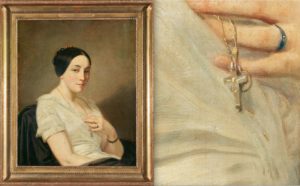Earlier this month, a painting looted by the Nazis was returned to the heirs of the rightful owner. German officials returned Portrait of a Seated Woman, a work by Thomas Couture, to the heirs of Georges Mandel. The looted work was identified while on display as part of the former collection of Cornelius Gurlitt.
THE GURLITT COLLECTION
In November 2013, the world became aware of the Gurlitt Collection. The find was unprecedented, as the Gurlitt Family had hidden an extraordinarily valuable and unknown art collection for decades. The Gurlitts possessed over 1400 works, most of which were collected while Hildebrand Gurlitt worked as an art dealer for the Nazi Party.
In 1937, the Nazis began ransacking public collections for anything modernist to be displayed as “degenerate,” and to ultimately be sold abroad or destroyed. In 1937, the Reich Minister of Propaganda in Nazi Germany issued a decree authorizing a commission to raid museums to select works for an exhibition of “degenerate” art. The Nazis confiscated thousands of works from museums and gathered them for “The Degenerate Art” exhibit. The works were displayed without a proper curatorial process, and some were even partially covered by pejorative slogans. After the exhibition, some objects were auctioned or sold, but thousands were destroyed in bonfires.
During this time, Hildebrand Gurlitt (Cornelius’ father), a collector in his own right, took the opportunity to steal works from collectors in Germany and France. Hundreds of works in the Gurlitt Collection are thought to be works declared as “degenerate,” while other works are suspected to have been the property of fleeing Jewish collectors. After Hildebrand Gurlitt gathered these works, he kept their existence a secret. When he passed away, the works went to family, unbeknownst to officials because the artwork did not go through the probate process.
DISCOVERY OF THE GURLITT COLLECTION
Decades later, in February 2012, based on a court order for tax-evasion allegations, the works were discovered and confiscated from Cornelius Gurlitt’s small apartment in Munich. At that point, a German provenance researcher examined the collection. The first task was to determine the identity of the works and artists, but there were countless unanswered questions about the art trove. How did these works make their way to the Gurlitt Family?
In the case of artworks bought from victims, there is legal precedent that dictates that works sold under duress are actually stolen. However, it is difficult to determine which works were stolen or were legitimately collected by Hildebrand Gurlitt. One of the difficulties in categorizing these works is the lack of information available about the objects. Each work is unique, and it is a complex task to determine the provenance (ownership history) of each object.
DIFFICULTIES RESTITUTING NAZI-LOOTED ART
Claimants (rightful owners or their heirs) must overcome the formidable task of proving ownership. When Jews and other victims of Nazi atrocities were forced to escape from their homes in fear, the ownership records of their art collections were not of the utmost importance. These people were fleeing for their lives, families were being torn apart, people were being murdered across a continent, and individuals were losing possession to every worldly object in their names. For this reason, the heirs of these victims face an uphill battle to recover property. These individuals face a formidable task—proving ownership without any documentation. And as time moves forward, Holocaust survivors pass away. Without their memories, the remaining heirs may be unaware of their families’ looted assets.
Yet even after the confiscation of the collection, the Gurlitt saga continued. Cornelius Gurlitt adamantly refused to return works from the collection to the legitimate owners, as he insisted that the works rightly belonged to him. And then on May 6, 2014, Gurlitt passed. In late 2014, it was revealed that he bequeathed the entire collection to a Swiss museum, Kunstmuseum Bern. The museum announced that it was “surprised and delighted” to have the paintings left to its collection. However, the museum recognized that the gift brought “a considerable burden of responsibility and a wealth of questions of the most difficult and sensitive kind, and questions in particular of a legal and ethical nature.” The museum ultimately accepted the gift, but committed to researching the artworks and cooperating in the restitution process for stolen works.
The difficulty in proving ownership is reflected in the small number of art restitutions. The Couture painting is only the fifth piece from the Gurlitt Collection to return to the rightful owners, and it is only the sixth work confirmed as looted by the Nazis. Interestingly, and luckily for the heirs, the painting was identified based on a distinctive mark– a tiny hole in the canvas that Mandel’s lover had described when she reported the work as stolen.
ADDITIONAL INFORMATION
For more information about the Gurlitt Collection, please find Monuments Men, Hidden Treasures, and the Restitution of Looted Art.
For more information about the Nazi Party and their destruction and theft of art, our founder Leila Amineddoleh contributed a chapter to Nazi Law: From Nurmeberg to Nuremberg.
